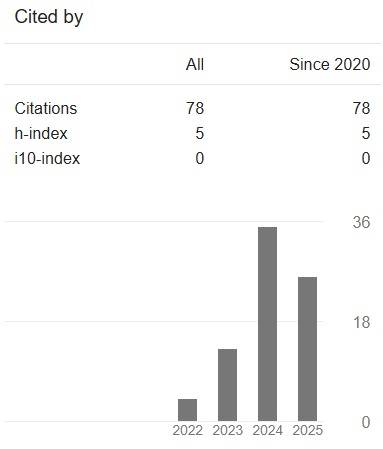Evaluation of Tribological Performances of Palm Oil-Blended Food Grade Lubrication
DOI:
https://doi.org/10.24191/jaeds.v4i2.80Keywords:
Palm oil, Industrial gear oil, Pin-on-Disc, Surface roughness, FTIRAbstract
Conventional industrial lubricants from mineral oil are recognized for their harmful effects on both humans and the environment. It has driven a worldwide shift to embrace food-grade lubricant due to their biodegradability, favourable viscosity, cost-effectiveness, and wide availability. This study evaluates the tribological performances of blended palm oil, assessing its suitability as an eco-friendly and efficient alternative in the industry. Although there have been numerous studies exploring the tribological performances of vegetable oils, research on the food-grade lubrication using a blend of palm oil and industrial gear oil still has potential for further improvement and advancement. Therefore, this investigation intends to measure the wear rate and coefficient of friction using the Pin-on-Disc tribometer according ASTM G-99 standard. Using industrial gear oil as the base, 15 different samples with concentrations of 0%, 15%, and 30% palm oil were tested under varying applied loads, ranging from 30N - 60N, and speeds ranging from 600 rpm - 900 rpm. Utilizing the Surftest machine SV600, both samples of S7L3P15 and S7L4P15 indicated the lowest surface roughness (Ra), which is 0.04 µm. Furthermore, the FTIR spectrometer demonstrated the presence of aliphatic hydrocarbons, olefins, and esters in the functional groups of both G70P30 and G85P15 sample oils. Beyond this point, out of 15 samples tested, 12 samples had wear rates under 50 (10-6) mm³/Nm and coefficients of friction below 0.1 in the Pin on Disc test. G70P30 is the optimum biolubricant concentration because it reduces wear rate and friction more than G100P0 and G85P15. In conclusion, the blended palm oil can increase the development of biodegradable and environment-friendly lubricant oil without concerns about downgrading the tribological performances.
Downloads
References
D. K. Karupannasamy and R. Ruthuraraj, “Synthesis of eco-friendly machining lubricants and its tribological characteristics,” International Journal of Recent Technology and Engineering, vol. 8, no. 3, pp. 1902–1906, Sep. 2019, doi: 10.35940/ijrte.C4466.098319.
M. Xu, X. Yu, and J. Ni, “Penetration and lubrication evaluation of vegetable oil with nanographite particles for broaching process,” Friction, vol. 9, no. 6, pp. 1406–1419, Dec. 2021, doi: 10.1007/s40544-020-0421-0.
O. R. Obanla, F. U. Mohammed, O. S. Alebiosu, M. E. Ojewumi, T. E. Oladimeji, and D. E. Babatunde, “Study on the Lubricating Properties of Castor (Ricinus communis) and Hydroxylated Rubber (Hevea brasiliensis) Seed Oil,” ACS Omega, vol. 6, no. 43, pp. 28471–28476, Nov. 2021, doi: 10.1021/acsomega.0c05810.
A. O. Osayi, S. A. Lawal, M. B. Ndaliman, and J. B. Agboola, “Performance evaluation of rubber seed oil based cutting fluid in turning mild steel,” Nigerian Journal of Technology, vol. 40, no. 4, pp. 648–659, Oct. 2021, doi: 10.4314/njt.v40i4.12.
A. M. Sabri et al., “Physical Properties of New Formulation of Hybrid Nanofluid-based Minimum Quantity Lubrication (MQL) from Modified Jatropha Oil as Metalworking Fluid,” Journal of Advanced Research in Fluid Mechanics and Thermal Sciences, vol. 101, no. 1, pp. 1–10, 2023, doi: 10.37934/arfmts.101.1.110.
M. Ullah, “Biodegradation of Petroleum Hydrocarbons and The Factors Effecting Rate of Biodegradation,” Am J Biomed Sci Res, vol. 16, no. 1, pp. 6–15, Mar. 2022, doi: 10.34297/ajbsr.2022.16.002182.
P. Nowak, K. Kucharska, and M. A. Kaminski, “The New Test Procedure for Group-Type Composition of Base Oils of Lubricating Oils, Especially Emitted into the Environment,” Energies (Basel), vol. 13, no. 15, Aug. 2020, doi: 10.3390/en13153772.
A. S. A. Sani, P. H. M. A. Radzi, A. M. Sabri, Z. Zamri, N. Chandran, and N. Talib, “Analysis Performance of Modified Tamanu Oil Enhanced with Additives as Potential Green Alternative in Metalworking Fluids,” International Journal of Integrated Engineering, vol. 14, no. 8, pp. 16–23, 2022, doi: 10.30880/ijie.2022.14.08.003.
R. G. Rengiah, “Effect of Coconut Oil-Based Cutting Fluid on Cutting Performance During Turning With Minimal Fluid Application,” International Journal of Manufacturing, Materials, and Mechanical Engineering, vol. 12, no. 1, pp. 1–14, Sep. 2022, doi: 10.4018/ijmmme.301611.
P. Nowak, K. Kucharska, and M. Kamiński, “Ecological and health effects of lubricant oils emitted into the environment,” Aug. 01, 2019, MDPI. doi: 10.3390/ijerph16163002.
E. J. Pieterman et al., “Chronic Oral Administration of Mineral Oil Compared With Corn Oil: Effects on Gut Permeability and Plasma Inflammatory and Lipid Biomarkers,” Front Pharmacol, vol. 12, Aug. 2021, doi: 10.3389/fphar.2021.681455.
J. Adekunle Oyedele Oyekunle et al., “Biodiesel Potentials and Lubricating Properties of Citrus Seed Oil,” International Journal of Bioorganic Chemistry, vol. 4, no. 2, p. 84, 2019, doi: 10.11648/j.ijbc.20190402.11.
M. F. Bin Abdollah, H. Amiruddin, and A. D. Jamallulil, “Experimental analysis of tribological performance of palm oil blended with hexagonal boron nitride nanoparticles as an environment-friendly lubricant,” International Journal of Advanced Manufacturing Technology, vol. 106, no. 9–10, pp. 4183–4191, Feb. 2020, doi: 10.1007/s00170-019-04906-5.
Nur Darina Ahmad, Nur Huda Ishak, Nik Muhamad Syazwan Nik Omar, Mohd Taufik Ishak, Siti Solehah Md Ramli, and Norlina Md Zain, A Study on Varies Temperature and Varies Gap Distance in Mixed Vegetable Oils in Transformer Oil. 2019, 2019.
O. Amelia, I. Sailah, I. A. Kartika, O. Suparno, and Y. Bindar, “Eco-friendly Alkyd Resins Based on Vegetable Oil: Review,” Jurnal Rekayasa Proses, vol. 15, no. 1, p. 1, Jun. 2021, doi: 10.22146/jrekpros.64143.
S. Bhaumik, B. R. Mathew, and S. Datta, “Computational intelligence-based design of lubricant with vegetable oil blend and various nano friction modifiers,” Fuel, vol. 241, pp. 733–743, Apr. 2019, doi: 10.1016/j.fuel.2018.12.094.
I. H. A. Razak, M. A. Ahmad, and N. N. N. A. Fuad, “The effects of palm oil with nanoclay additive in hydrodynamic journal bearing lubrication,” Int J Eng Adv Technol, vol. 9, no. 1, pp. 5936–5942, Oct. 2019, doi: 10.35940/ijeat.A3031.109119.
J. A. Cecilia, D. B. Plata, R. M. A. Saboya, F. M. T. de Luna, C. L. Cavalcante, and E. Rodríguez-Castellón, “An overview of the biolubricant production process: Challenges and future perspectives,” Mar. 01, 2020, MDPI AG. doi: 10.3390/pr8030257.
J. Nadia, “A Review on New Trends, Challenges and Prospects of Ecofriendly Friendly Green Food-Grade Biolubricants,” Biointerface Res Appl Chem, vol. 12, no. 1, pp. 1185–1207, Apr. 2021, doi: 10.33263/briac121.11851207.
N. A. Raof, H. A. Hamid, N. A. Mohamad Aziz, and R. Yunus, “Prospects of Plant-Based Trimethylolpropane Esters in the Biolubricant Formulation for Various Applications: A Review,” Feb. 28, 2022, Frontiers Media S.A. doi: 10.3389/fmech.2022.833438.
M. A. Dandan, A. Yahaya, and S. Syahrullail, “The effect of the different percentage of pour point depressant (PPD) on the tribological properties of palm kernel oil,” Tribology in Industry, vol. 41, no. 3, pp. 365–374, 2019, doi: 10.24874/ti.2019.41.03.06.
A. Yahaya, S. Samion, U. Abidin, and M. K. Abdul Hamid, “Different Behaviors of Friction in Open and Closed Forging Test Utilizing Palm Oil-Based Lubricants,” Lubricants, vol. 11, no. 3, Mar. 2023, doi: 10.3390/lubricants11030114.
U. S. Ramli et al., “Sustainable palm oil—The role of screening and advanced analytical techniques for geographical traceability and authenticity verification,” Jun. 01, 2020, MDPI AG. doi: 10.3390/molecules25122927.
P. Zulhanafi and S. Syahrullail, “The tribological performances of Super Olein as fluid lubricant using four-ball tribotester,” Tribol Int, vol. 130, pp. 85–93, Feb. 2019, doi: 10.1016/j.triboint.2018.09.013.
A. Dandan, “Palm oil as an alternative lubricant oil: A brief review,” 2017. [Online]. Available: http://arifdandan92@gmail.com,
Z. Azhary, M. Salleh, S. Samion, N. Ngadi, N. N. Ruslan, and E. A. Rahim, “The tribological performance of modified RBD palm kernel oil under extreme pressure load test,” 2019.
M. A. Ijaz Malik, M. A. Kalam, M. A. Mujtaba, and F. Almomani, “A review of recent advances in the synthesis of environmentally friendly, sustainable, and nontoxic bio-lubricants: Recommendations for the future implementations,” Nov. 01, 2023, Elsevier B.V. doi: 10.1016/j.eti.2023.103366.
A. K. Judran, N. Abd-Alkadhim, and H. T. Hussein, “Study of the influence of surface roughness, Sample heat and Sample shape on Wear rate measurements,” Engineering and Technology Journal, vol. 31, no. 2 B, pp. 252–260, Feb. 2013, doi: 10.30684/etj.31.2b.12.
J. Liu, S. Xue, K. Zhang, and H. Pang, “Failure modeling and reliability analysis for motion mechanism with clearance joints under plastic deformation and wear,” Eksploatacja i Niezawodnosc, vol. 25, no. 3, 2023, doi: 10.17531/ein/169920.
L. Raja Moorthi, J. I. Inayat-Hussain, and A. Abidin Zakaria, “Effect of wear on the dynamic characteristics of a rigid rotor supported by journal bearings,” Sci Rep, vol. 14, no. 1, Dec. 2024, doi: 10.1038/s41598-024-60488-7.
M. J. Neale, “Wear-Materials, Mechanisms and Practice,” 2005.
M. Leus and P. Gutowski, “Friction Force Reduction Efficiency in Sliding Motion Under Tangential Vibrations of Elastic Support,” Acta Mechanica et Automatica, vol. 18, no. 1, pp. 101–109, Mar. 2024, doi: 10.2478/ama-2024-0013.
L. Irimescu and S. Alaci, “Considerations on friction coefficient in a simple harmonic motion,” in IOP Conference Series: Materials Science and Engineering, Institute of Physics Publishing, Nov. 2018. doi: 10.1088/1757-899X/444/2/022018.
Y. Chen, L. Jiang, and L. Qian, “AFM probe for measuring ∼10−5 ultra-low friction coefficient: Design and application,” Friction, vol. 12, no. 1, pp. 64–73, Jan. 2024, doi: 10.1007/s40544-022-0731-5.
Y. Gao, H. Li, D. Zhao, M. Wang, and X. Fan, “Advances in friction of aluminium alloy deep drawing,” Mar. 01, 2024, Tsinghua University. doi: 10.1007/s40544-023-0761-7.
M. Khafidh, D. J. Schipper, and M. A. Masen, “The Formation of a Modified Surface Layer on Elastomeric Materials,” Tribol Lett, vol. 67, no. 1, Mar. 2019, doi: 10.1007/s11249-019-1140-4.
O. Sirin, A. Barrea, P. Lefèvre, J. L. Thonnard, and C. Basdogan, “Fingerpad contact evolution under electrovibration,” J R Soc Interface, vol. 16, no. 156, 2019, doi: 10.1098/rsif.2019.0166.
M. Heß and F. Forsbach, “Macroscopic Modeling of Fingerpad Friction Under Electroadhesion: Possibilities and Limitations,” Front Mech Eng, vol. 6, 2020, doi: 10.3389/FMECH.2020.567386.
J. Liu and Y. Ou, “Dynamic axial contact stiffness analysis of position preloaded ball screw mechanism,” Advances in Mechanical Engineering, vol. 11, no. 1, Jan. 2019, doi: 10.1177/1687814018819289.
F. N. Maluin, M. Z. Hussein, and A. S. Idris, “An overview of the oil palm industry: Challenges and some emerging opportunities for nanotechnology development,” 2020, MDPI AG. doi: 10.3390/agronomy10030356.
M. M. Hussain, A. P. Pratap, and V. R. Gaval, “Study of vegetable oil based biolubricants and its hydrodynamic journal bearing application: A review,” Dec. 01, 2021, Faculty of Engineering, University of Kragujevac. doi: 10.24874/ti.979.10.20.02.
S. Shankar, M. Manikandan, G. Raja, G. S. Priyadharashini, and A. Pramanik, “Experimental studies on viscosity, thermal and tribological properties of vegetable oil (kapok oil) with boric acid as an additive,” Micro Nano Lett, vol. 16, no. 5, pp. 290–298, Apr. 2021, doi: 10.1049/mna2.12045.
V. Kumbár and J. Votava, “Excessive additive effect on engine oil viscosity,” Acta Universitatis Agriculturae et Silviculturae Mendelianae Brunensis, vol. 62, no. 5, pp. 1015–1020, 2014, doi: 10.11118/actaun201462051015.
L. Kerni, A. Raina, and M. I. U. Haq, “Friction and wear performance of olive oil containing nanoparticles in boundary and mixed lubrication regimes,” Wear, vol. 426–427, pp. 819–827, Apr. 2019, doi: 10.1016/j.wear.2019.01.022.
T. Gadekar and D. Kamble, “Tribological investigation on oil blended with Additive using Response surface methodology”, doi: 10.1051/conf/202017001025.
A. Yahaya, S. Samion, M. Kameil, and A. Hamid, “Surface modification effect of aluminium block on the tribological performance for super olein,” vol. 75, no. 9, pp. 993–1001, 2023, doi: 10.1108/ILT-07-2023-0200/Keywords.
M. Sejkorova and I. Hurtova, “Engine oil analysis - Effective instrument to evaluate reliability of tractor engines,” in Engineering for Rural Development, Latvia University of Life Sciences and Technologies, 2019, pp. 971–976. doi: 10.22616/ERDev2019.18.N059.
K. Achtenberg, J. Mikołajczyk, and Z. Bielecki, “Two-Channel Detecting Sensor with Signal Cross-Correlation for FTIR Instruments,” Sensors, vol. 22, no. 22, Nov. 2022, doi: 10.3390/s22228919.
G. Antoniou, J. J. A. Conn, B. R. Smith, P. M. Brennan, M. J. Baker, and D. S. Palmer, “Recurrent neural networks for time domain modelling of FTIR spectra: application to brain tumour detection,” Analyst, vol. 148, no. 8, pp. 1770–1776, Mar. 2023, doi: 10.1039/d2an02041f.
B. R. Shakya, H. R. Teppo, and L. Rieppo, “Optimization of measurement mode and sample processing for FTIR microspectroscopy in skin cancer research,” Analyst, vol. 147, no. 5, pp. 851–861, Mar. 2022, doi: 10.1039/d1an01999f.
W. Cowger et al., “High Throughput FTIR Analysis of 1 Macro and Microplastics with Plate 2 Readers,” 2023.
C. Waldhans, M. Hebel, U. Herbert, P. Spoelstra, S. Barbut, and J. Kreyenschmidt, “Microbial investigation of cleanability of different plastic and metal surfaces used by the food industry,” J Food Sci Technol, vol. 60, no. 10, pp. 2581–2590, Oct. 2023, doi: 10.1007/s13197-023-05778-0.
P. A. Domde, H. J. Purohit, R. S. Kashyap, and S. S. Wagh, “Biodegradation of Aliphatic Hydrocarbon Compounds by Bacterial Cultures,” International Journal of Current Science Research and Review, vol. 06, no. 04, Apr. 2023, doi: 10.47191/ijcsrr/V6-i4-04.
A. Kazemi, H. Parvaresh, M. D. Qanateghestani, and S. Ghasemi, “A Study on Source Identication of Contaminated Soil with total Petroleum Hydrocarbons (Aromatic and Aliphatic) in the Ahvaz Oil Field,” 2024, doi: 10.21203/rs.3.rs-3893337/v1.
D. K. Chaudhary, R. Bajagain, S. W. Jeong, and J. Kim, “Biodegradation of diesel oil and n-alkanes (C18, C20, and C22) by a novel strain acinetobacter sp. K-6 in unsaturated soil,” Environmental Engineering Research, vol. 25, no. 3, pp. 290–298, Jun. 2020, doi: 10.4491/eer.2019.119.
D. Lestari et al., “Rapid Detection of Rat Meat Adulteration in Beef Sausages Using FTIR-A T R Spectroscopy And Chemometrics For Halal Authentication,” International Journal of Applied Pharmaceutics, vol. 16, no. Special Issue 1, pp. 82–88, 2024, doi: 10.22159/ijap.2024.v16s1.21.
Z. J. Berkson et al., “Molecularly defined lubricant hydrocarbons from olefin metathesis,” 2023, doi: 10.26434/chemrxiv-2023-jtvvr.
C. Murru, R. Badía-Laíño, and M. E. Díaz-García, “Oxidative Stability of Vegetal Oil-Based Lubricants,” Feb. 01, 2021, American Chemical Society. doi: 10.1021/acssuschemeng.0c06988.
R. D. Kusumaningtyas, H. Prasetiawan, N. D. Anggraeni, E. D. N. Anisa, and D. Hartanto, “Conversion of Free Fatty Acid in Calophyllum inophyllum Oil to Fatty Acid Ester as Precursor of Bio-Based Epoxy Plasticizer via SnCl2–Catalyzed Esterification,” Polymers (Basel), vol. 15, no. 1, Jan. 2023, doi: 10.3390/polym15010123.
Y. Wang, Q. Qiu, P. Zhang, X. Gao, Z. Zhang, and P. Huang, “Correlation between Lubricating Oil Characteristic Parameters and Friction Characteristics,” Coatings, vol. 13, no. 5, May 2023, doi: 10.3390/coatings13050881.
H. Wang et al., “Low-viscosity oligoether esters (OEEs) as high-efficiency lubricating oils: Insight on their structure–lubricity relationship
Downloads
Published
How to Cite
Issue
Section
License
Copyright (c) 2024 Mohamad Mazwan Mahat, Nur Syuhada Iman Ahdul Talib, Wan Zulhilmi Wan Suhaidi, Nurul Nadiah Mohd Kamaldin

This work is licensed under a Creative Commons Attribution 4.0 International License.









